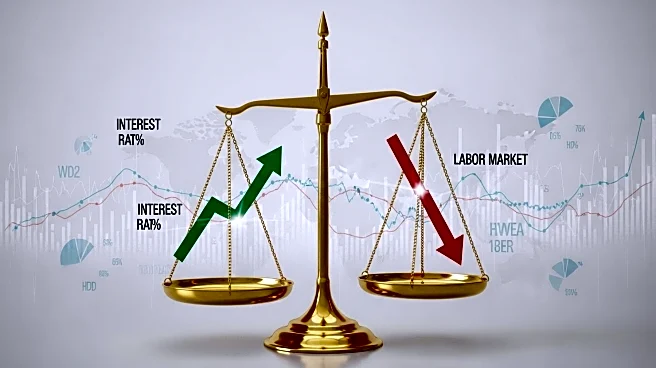What's Happening?
The Federal Reserve is set to reduce its key interest rate by 25 basis points on September 17, 2025, as indicated by a Reuters poll of 107 economists. This decision comes in response to a slowdown in labor market demand, which has overshadowed inflation risks. The rate cut will bring the federal funds rate to a range of 4.00%-4.25%, marking the first reduction this year. The poll suggests that the Fed may implement further cuts, with expectations of an additional 75 basis points reduction by the end of the year. This move is seen as a measure to support the labor market, which has shown signs of stalling job growth and downward revisions in job data.
Why It's Important?
The anticipated rate cut by the Federal Reserve is significant as it reflects the central bank's shift in focus from inflation control to labor market support. This decision could have broad implications for the U.S. economy, potentially stimulating economic activity by making borrowing cheaper for businesses and consumers. However, it also raises concerns about the Fed's ability to balance inflation risks with labor market needs. The move may benefit sectors reliant on consumer spending and investment, but it could also lead to dissent among Fed policymakers who are cautious about inflationary pressures.
What's Next?
Following the rate cut, the Federal Reserve may face increased scrutiny regarding its monetary policy direction. Economists predict further rate reductions, contingent on labor market conditions and inflation trends. The appointment of a new Fed chair could influence future policy decisions, with expectations of a more dovish approach. Stakeholders, including businesses and political leaders, will likely monitor the Fed's actions closely, assessing the impact on economic growth and inflation.
Beyond the Headlines
The Federal Reserve's decision to cut interest rates highlights the complex dynamics of economic policymaking, where labor market health and inflation control must be balanced. This situation underscores the challenges faced by central banks in maintaining economic stability amid fluctuating market conditions. The potential for policy errors and dissent among Fed members could lead to debates about the independence and effectiveness of the central bank.











